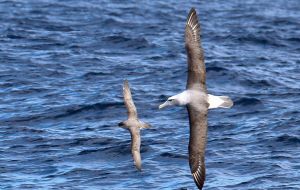MercoPress. South Atlantic News Agency
Seabirds threatened by by-catches, pollutants and climate change, according to BAS research
 Lead author Dr Richard Phillips from BAS says seabirds become hooked on baited hooks, trapped in nets or collide with warp cables, when scavenging for food
Lead author Dr Richard Phillips from BAS says seabirds become hooked on baited hooks, trapped in nets or collide with warp cables, when scavenging for food  Of 29 albatross and large petrels species covered by ACAP, 19 are threatened by the IUCN: 11 are Vulnerable, 5 Endangered and 3 Critically Endangered.
Of 29 albatross and large petrels species covered by ACAP, 19 are threatened by the IUCN: 11 are Vulnerable, 5 Endangered and 3 Critically Endangered. A review of breeding distributions, population trends, threats and key priorities for conservation actions on land and at sea for the 29 species covered by the Agreement on the Conservation of Albatrosses and Petrels (ACAP) has been published in the journal Biological Conservation. It reveals increased conservation efforts are required in order to secure a sustainable future for albatrosses and large petrels.
The research shows that the global populations of 38% of these species declined, 28% increased and 28% remained stable over the last two decades (1993-2013). The trend for 7% (2 species) is unknown.
Researchers examined a range of factors including foraging distributions, overlap with fisheries, population status and trends, and marine and terrestrial threats to evaluate current conservation priorities for these vulnerable species.
Seabirds are amongst the most globally-threatened of all groups of birds. Of the 29 albatross and large petrels species covered by the ACAP, 19 are listed as threatened by the IUCN: 11 are Vulnerable, 5 Endangered and 3 are Critically Endangered. Most of the remaining species are listed as Near Threatened (8), and just two species are listed as Least Concern.
Although conservation management has improved in recent years, the review highlights that these species still face a wide range of threats in both marine and terrestrial environments
Bycatch continues to pose the greatest threat to albatrosses and large petrel species, with a growing number of studies highlighting the negative relationship between long-line, trawl and other fisheries, and seabird population trends.
Lead author Dr Richard Phillips from British Antarctic Survey says: “By-catch mainly occurs as seabirds become hooked on baited hooks, trapped in nets or collide with warp cables, when scavenging for food on the sea surface. The threat is intensified because adult seabirds travel long distances, and therefore can encounter multiple fisheries during their journey.
Other threats include alien species, which have a major impact on breeding success of albatrosses and petrels at some sites, pollution (particularly the bioaccumulation of marine pollutants) and climate change.
This study highlights the need for continuing efforts to improve management and monitoring of the threats to these vulnerable seabirds, in order to secure a positive future.”




Top Comments
Disclaimer & comment rules-

Read all commentsWell, Mr Phillips is setting a fine example here. Regular infidels have to stay 30 meters away from these precious -almost extinct- birds, and he is about sitting on its lap!
Aug 10th, 2016 - 11:17 am 0And that only for a selfie!
Commenting for this story is now closed.
If you have a Facebook account, become a fan and comment on our Facebook Page!